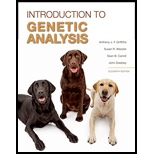
Introduction to Genetic Analysis
11th Edition
ISBN: 9781464109485
Author: Anthony J.F. Griffiths, Susan R. Wessler, Sean B. Carroll, John Doebley
Publisher: W. H. Freeman
expand_more
expand_more
format_list_bulleted
Concept explainers
Question
Chapter 1, Problem 12P
Summary Introduction
To determine: The number of cytosines, thymine, and guanine in a DNA double helix with 100 base pairs and 32 adenines.
Introduction: The DNA consists of four nitrogenous bases that are adenine, cytosine, guanine, and thymine. The nitrogenous base pairs are pyrimidine (thymine and cytosine) and purine (adenine and guanine), which base pairs with each other. The base pairs are joined by weak hydrogen bonding.
Expert Solution & Answer
Want to see the full answer?
Check out a sample textbook solution
Students have asked these similar questions
If a DNA double helix that is 100 base pairs in length has32 adenines, how many cytosines, guanines, and thymines must it have?
If a DNA double helix contains 28% T nucleotides, then what is the percentage of A nucleotides?
In a segment of DNA consisting of 1000 nitrogen bases,
28% of which are thymine, how many bases are
adenine, guanine, and cytosine?
Knowledge Booster
Learn more about
Need a deep-dive on the concept behind this application? Look no further. Learn more about this topic, biology and related others by exploring similar questions and additional content below.Similar questions
- What is the sequence of amino acids coded by the following sequence of nucleotides on a strand of DNA from the 5' to 3' end? A - T - C - G - C - T - A - C - G - A - A - T How many nucleotides are there?arrow_forwardA double-stranded molecule of B DNA contains 340 nucleotides. How many complete turns occur in this double helix?arrow_forwardOne DNA chain of a DNA double helix contains 18% A, 35% T, 28% C, and 21% G. What is the composition of the complementary DNA chain?arrow_forward
- If one side of DNA molecule had a base sequence of adenine-adenine-guanine-cytosine-thymine-cytosine-thymine, what would the sequence of bases on the opposite side of the molecule be?arrow_forwardA double-stranded DNA molecule is 1 cm long, and the percentage of adenine is 15%. How many cytosines does this DNA molecule contain?arrow_forwardHow many hydrogen bonds will be involved in base pairing in a DNA molecule of 100 base pairs that contains 30 cytosine bases?arrow_forward
- In a single strand of DNA, is it ever possible for the number of adenines to be greater than the number of thymines? Describearrow_forwardHow many combinations of DNA bases are for a polynucleotide of 7 base pairs in length?arrow_forwardWhat are the three components of a nucleotide? With regard to the 5′ and 3′ positions on a sugar molecule, how are nucleotides linked together to form a strand of DNA?arrow_forward
- TRUE OR FALSE a) The 2 chains composing one double helix run in opposite directions; they are antiparallel (one is 5’->3’ and the other 3’->5’). b) DNA molecules can perform their function in replication and transcription as long as the hydrogen bonds between the bases remain intact.arrow_forwardHow long (Å) is an alpha helix of 16 amino acid residues?arrow_forwardA segment of DNA containing 20 base pairs includes 7 guanine residues. How many adenine residues are in the segment? How many uracil residues are in the segment?arrow_forward
arrow_back_ios
SEE MORE QUESTIONS
arrow_forward_ios
Recommended textbooks for you
 Human Heredity: Principles and Issues (MindTap Co...BiologyISBN:9781305251052Author:Michael CummingsPublisher:Cengage Learning
Human Heredity: Principles and Issues (MindTap Co...BiologyISBN:9781305251052Author:Michael CummingsPublisher:Cengage Learning

Human Heredity: Principles and Issues (MindTap Co...
Biology
ISBN:9781305251052
Author:Michael Cummings
Publisher:Cengage Learning
DNA vs RNA (Updated); Author: Amoeba Sisters;https://www.youtube.com/watch?v=JQByjprj_mA;License: Standard youtube license